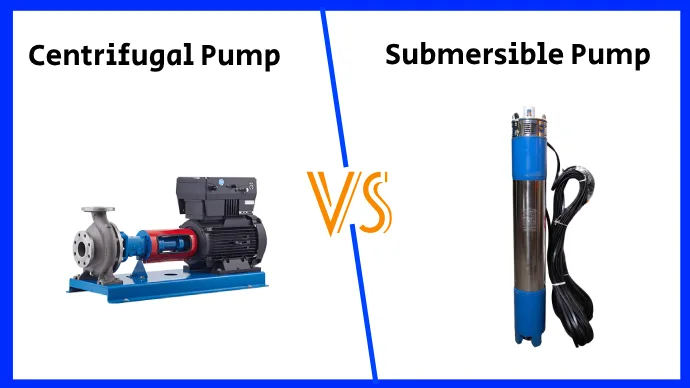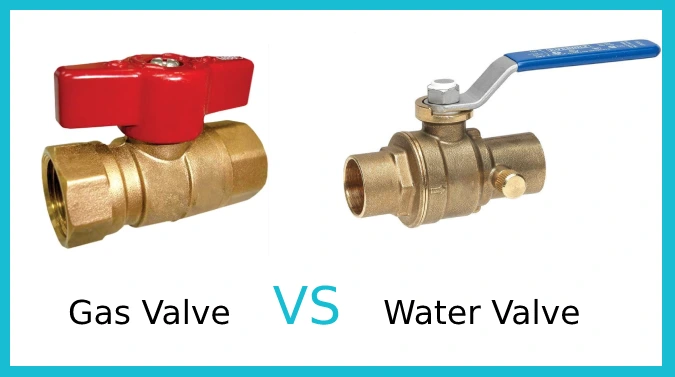Last Updated on July 23, 2023
Centrifugal and submersible pumps are two popular types used to move water for various purposes. While they have the same end goal, they differ in how and where they are installed. With their unique properties, understanding the differences between these pumps can help you make informed water pumping decisions.
Submersible pumps are located underwater, while centrifugal pumps are situated on the ground. Centrifugal pumps are suitable for urban or industrial irrigation and drainage. Submersible pumps are commonly used to extract groundwater from deep wells.
Today we will explore the differences between the two pumps and when they are most suitable for use. Knowing the differences between these pumps is crucial for anyone in the water supply industry or involved in groundwater extraction. So let’s get started.
Key Differences Between Centrifugal Pumps and Submersible Pumps

If you’re considering purchasing a pump, you must understand the key differences between centrifugal and submersible pumps. These differences include installation location, pump functionality, and pumping capabilities.
- Design and Construction
- Installation Location
- Pump Functionality
- Operating Conditions
- Suitable Applications
Design and Construction:
Centrifugal pumps consist of a casing, impeller, and shaft, often made with stainless steel, cast iron, or bronze materials. But, these components are exposed to the atmosphere, impacting their performance and durability. Also, centrifugal pumps require a separate motor, increasing the complexity and cost.
Submersible pumps offer a hermetically sealed motor, preventing exposure to the transfer media. Made with materials like stainless steel, aluminum, or thermoplastic, these pumps have an integrated motor and pump design, resulting in a more compact and efficient system.
Installation Location:
When installing a submersible pump in your pond or tank, you’ll have a hassle-free pumping experience as the pump is designed for submersion in water. This eliminates exposure to transfer media and any risk of contamination. Submersible pumps are perfect for pumping clean water and other liquids.
In comparison, centrifugal pumps must be kept above ground and aren’t suitable for submersion in water, requiring manual priming. They also require more complex installation procedures and regular maintenance for optimal function.
Pump Functionality:
Submersible pumps can pump out larger solids or grind them into smaller quantities, making them ideal for:
- Wastewater services
- Firefighting
- Rescue missions
Also, submersible pumps are more energy-efficient than centrifugal pumps, and their compact design makes them ideal for confined spaces.
Conversely, centrifugal pumps are primarily used for transporting various liquid substances in industrial, agricultural, or domestic applications. They excel at handling liquids with solid particles, making them suitable for mining, power plants, metallurgy, and more.
High-flow, low-pressure centrifugal pumps convert centrifugal force into kinetic energy to propel water out. These pumps handle various substances, including water, chemicals, and slurries. However, they’re unsuitable for pumping out larger solids, where submersible pumps excel.
Operating Conditions:
As submersible pumps operate fully submerged in water, they’re perfect for applications with dramatic changes in water level. In flooded areas, fields, and to pump sewage and water from deep wells, these pumps are known for their capacity to deliver high flow rates.
In contrast, centrifugal pumps require water to fill the casing and suction pipe before they can run. These pumps are used in irrigation systems, water treatment plants, and industrial processes that deal with corrosive and abrasive fluids. Centrifugal pumps offer excellent resistance to fluid damage and work best for this task.
Suitable Applications:
Submersible pumps are great for pumping water from submerged areas like farms, high-altitude areas for human and livestock consumption, cooling systems, construction sites, and similar locations. These pumps have been designed for efficient, low-maintenance operation and are suitable for domestic and industrial use.
Alternatively, centrifugal pumps are good for robustness and require minimal maintenance, making them a cost-effective option for several applications.
What are centrifugal pumps otherwise known as?

Centrifugal pumps, also known as kinetic or roto-dynamic machines. By exploiting centrifugal force, these pumps create a pressure difference to convert mechanical energy into hydraulic energy efficiently.
As such, they can move substantial fluid volumes quickly and smoothly. This makes them particularly effective in water treatment plants, irrigation systems, and industrial processes.
These pumps are versatile and can transport fluids with different viscosities, making them a practical solution across multiple contexts.
What are the 3 types of centrifugal pumps?
You’ll be interested to know that centrifugal pumps come in three different types:
Single-stage centrifugal pumps are the most commonly used type and are ideal for low to moderate flow rates. They have a simple design that consists of a single impeller that rotates within a volute casing. Single-stage pumps are often used for water supply, irrigation, and drainage applications.
Two-stage centrifugal pumps have two impellers stacked at each other for high flow rates. The first impeller boosts the fluid pressure, while the second impeller provides additional pressure. Two-stage pumps are often used in industrial applications such as chemical processing, oil refineries, and wastewater treatment plants.
Multi-stage centrifugal pumps have multiple impellers that are arranged in series. They are often used in high-pressure water treatment, boiler feed, and fire suppression systems. Oil and gas companies also use multi-stage pumps to increase production by injecting water or other fluids into wells.
Can a centrifugal pump be used on a well?
A centrifugal pump is suitable for shallow wells up to 25 feet deep but is not commonly used in wells due to its limitations. Here are some reasons why:
- Limited suction power: Centrifugal pumps rely on suction to draw water into the pump, but their suction power is limited compared to other types of pumps. This means they may be unable to pull water up from deeper wells.
- Low pressure: Centrifugal pumps are designed to move water at high flow rates but at low pressure. This makes them ideal for applications such as irrigation and circulation but not for applications that require high water pressure, such as domestic water supply.
- Prone to cavitation: When a centrifugal pump operates at high speeds, it can create a low-pressure zone in the impeller. This can cause the water to vaporize, creating bubbles that collapse when they reach high-pressure areas. This phenomenon is known as cavitation, and it can cause damage to the pump over time.
Why is a centrifugal pump widely used?
Centrifugal pumps are widely used because they can quickly move large volumes of liquid. Unlike positive displacement pumps, which move liquid in steps, centrifugal pumps use an impeller to generate a centrifugal force that pushes liquid outward.
This design allows flow rates of up to 20,000 gallons per minute, making centrifugal pumps ideal for transferring large volumes of low viscosity water.
These pumps are also versatile in handling a wide range of liquids. Furthermore, centrifugal pumps are easy to install and maintain, with fewer moving parts, reducing the risk of mechanical failure and ownership costs.
Can a centrifugal pump handle dirty water?
Unfortunately, centrifugal pumps aren’t designed to handle dirty water. The narrow impeller vanes of a centrifugal pump are easily clogged by debris, which can cause the pump to fail or become less efficient.
To avoid the problems associated with debris, choosing a pumping system designed to handle dirty water is important. Submersible pumps are a popular alternative to centrifugal pumps because they can handle a wide range of water types, including water that contains debris.
Is a deep well pump a centrifugal pump?
If you need to extract water from deep underground sources, the deep well pump is a reliable and efficient option. This type of centrifugal pump has multiple impellers and is perfect for pumping dirty water. The water-cooled motor prevents overheating by installing it at the bottom of the well.
It is possible to customize the length of the connection cable according to the individual’s needs. The deep well pump’s multi-staged design increases water pressure and flow rate, making it an ideal solution for inaccessible sources.
What causes a submersible pump to fail?

Submersible pump failure can occur due to various reasons. The primary cause is clogging, which happens when debris blocks the pump, leading to its failure. This can be avoided by regularly cleaning and removing debris.
Electrical faults, such as wiring or pump motor problems, can also cause failure. Overheating from working too hard can harm internal components and cause the pump to malfunction. Proper installation and maintenance can prevent these problems.
Prolonged use or incorrect installation can also lead to wear and tear, cavitation, and waterlogging, resulting in pump failure. Regular inspections and addressing any issues early can prevent further damage and extend your pump’s lifetime.
Which is better: a 2-wire or 3-wire submersible pump?
Regarding submersible pumps, choosing between a 2-wire or 3-wire one can feel like a life-or-death decision. The main difference between the two is the control box.
A 2 wire submersible pump has the control box built into the motor, while a 3-wire submersible pump has a separate control box mounted above ground. The advantage of a 2 wire submersible pump is that it is easier to install and requires less maintenance.
In contrast, a 3-wire submersible pump is more reliable and efficient for larger motors because it has a separate control box. If you need a submersible pump with a motor larger than 1.5 HP, using a 3-wire submersible pump is recommended.
Centrifugal vs Submersible Pumps: Knowing the Difference for Better Water Pumping Decisions
It’s important to understand the difference between centrifugal and submersible pumps to make well-informed decisions about water pumping. Centrifugal pumps are great for handling large volumes and low-viscosity fluids, while submersible pumps are the way to go for pumping water from deep wells.
However, don’t count out centrifugal pumps for dirty water, they are ideal for use in wastewater treatment plants and industrial settings. And if you’re wondering, deep well pumps actually fall under the centrifugal category.
By understanding the nuances of each pump type, you can confidently select the best one for your specific use case, whether pumping from a well or wastewater treatment.



